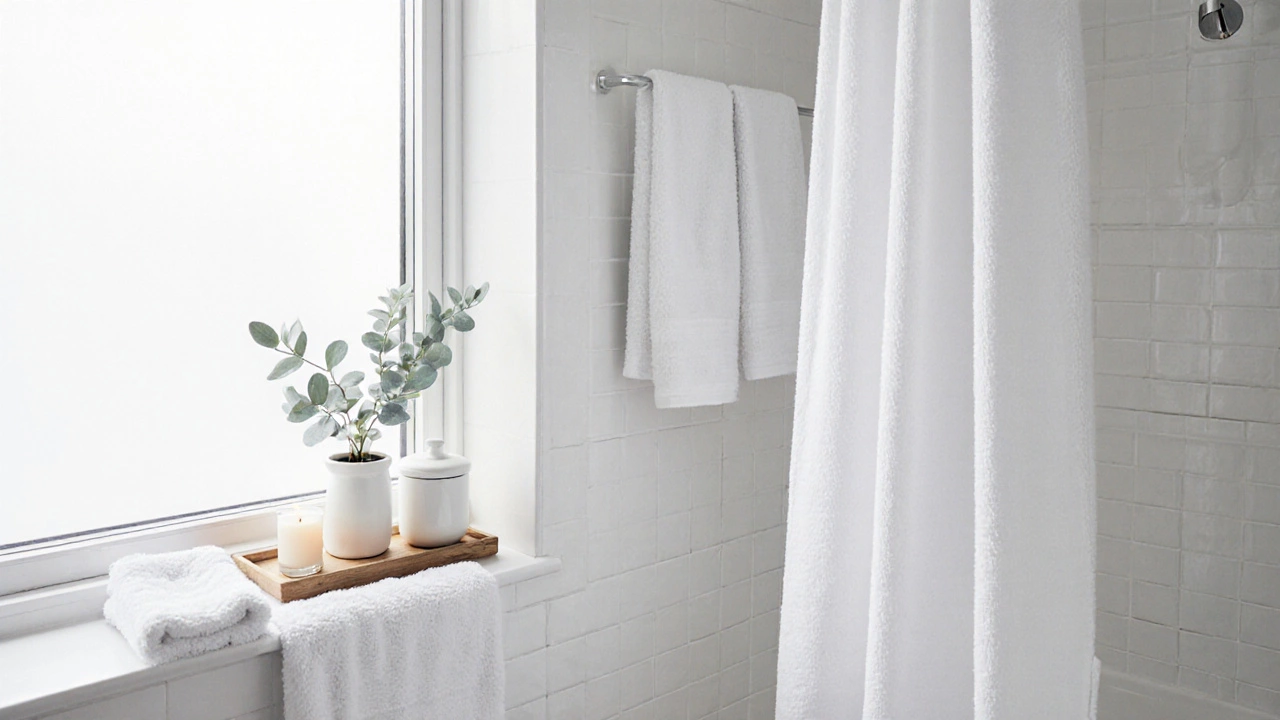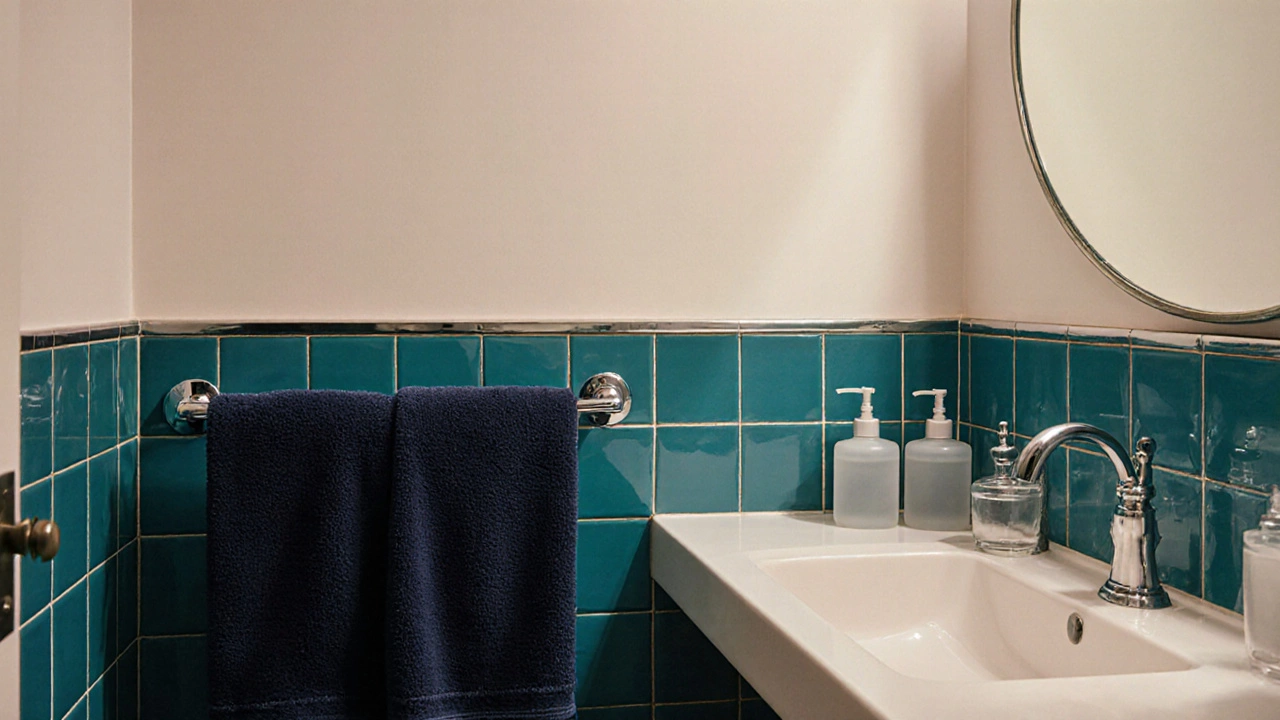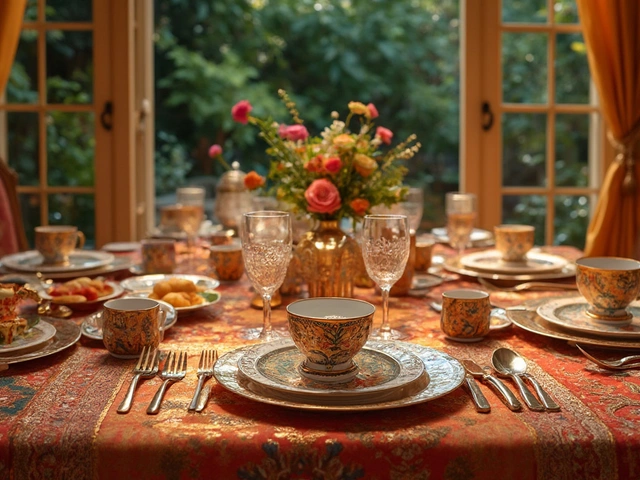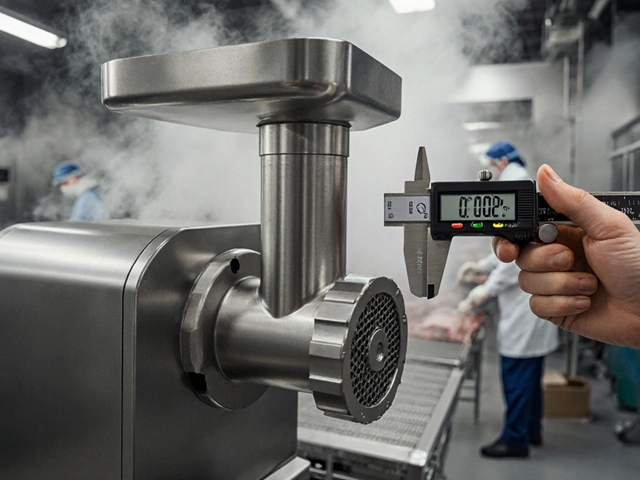
Choosing the right color for your bathroom accessories isn’t just about picking what looks nice-it’s about creating a space that feels calm, clean, and intentionally put together. Too many people grab matching sets from the big-box store without thinking about how the colors interact with their tiles, fixtures, and lighting. The result? A bathroom that feels cluttered, dated, or just plain off.
Start with your fixtures and tiles
Before you even look at towels or soap dispensers, take a hard look at your sink, tub, toilet, and tiles. These are your permanent elements. If you’ve got white porcelain fixtures and subway tiles, you’ve got a blank canvas. That’s great-it means you can go bold or soft, depending on your mood. But if your tiles are a warm beige or your tub has a brushed nickel finish, your accessories need to play along.
Here’s a simple rule: match the metal tones. If your faucet and showerhead are chrome, stick with chrome-finished soap dispensers, toothbrush holders, and towel bars. Same goes for matte black, brass, or bronze. Mixing metals in a small space like a bathroom makes it feel messy. You don’t need everything to match perfectly, but the dominant metal should show up in at least two or three accessories.
Neutral is your safest bet-and your most powerful tool
Most experts agree: neutral-colored accessories (white, cream, gray, black) work in almost every bathroom. Why? Because they don’t fight with anything. A white cotton towel looks crisp against dark gray tiles. A matte black soap dispenser pops against white walls. Neutral doesn’t mean boring-it means flexible.
Think about hotels. They use neutral accessories because they’re designed to feel clean, calming, and timeless. You don’t walk into a hotel bathroom and think, "Wow, those turquoise soap bottles are bold." You think, "This feels peaceful." That’s the goal.
If you’re unsure, start with white or gray towels, a white shower curtain, and black or chrome hardware. You can always add color later with smaller items like a single patterned mat or a scented candle.
When to add color-and how to do it right
Color in the bathroom isn’t off-limits. It just needs to be controlled. The biggest mistake people make is choosing accessories in bright, clashing hues. Neon green toothbrush holders? Red towels? They look like they belong in a 90s kids’ bathroom, not yours.
Instead, pick one or two accent colors and repeat them. If your shower curtain has a subtle blue geometric print, choose a blue bath mat and a blue soap dispenser. Keep the rest neutral. That way, the color feels intentional, not random.
Soft tones like sage green, dusty rose, or muted teal are trending in 2025 because they feel calming, not loud. They work well with natural materials like wood, stone, and linen. A sage green towel set paired with a bamboo tray and white ceramic jars creates a spa-like vibe without screaming for attention.
Pro tip: Look at your bathroom lighting. Natural light changes color throughout the day. A towel that looks gray in morning sun might look blue under artificial light. Buy samples. Hold them up in your bathroom at different times before you commit.

Texture matters as much as color
Color isn’t just about paint or fabric dye-it’s also about surface. A white cotton towel feels different than a white terry cloth one. A matte black metal soap dispenser reads differently than a glossy black plastic one.
Combine textures to add depth. Try pairing a chunky knit bath mat with smooth ceramic jars and a woven basket for toilet paper. Even if everything is the same color, different textures make the space feel layered and expensive.
One of the most underrated tricks? Use wood. A small wooden tray under your sink, or a bamboo toilet paper holder, adds warmth. It softens cold surfaces like porcelain and tile. And it works with every color scheme-from all-white to moody charcoal.
Don’t forget the small stuff
It’s easy to focus on towels and soap dispensers and forget the tiny details. But those are the ones that stick in your mind. A toothbrush holder that’s a different shade than your soap dish? It looks like an afterthought. A mismatched trash can? It breaks the flow.
Here’s how to fix it: buy your accessories as a set-or at least from the same brand and collection. Even if the set is basic, having matching shapes, finishes, and tones creates unity. You can always upgrade one piece later if you find something you love.
Also, avoid clear plastic. It looks cheap. Even if it’s functional, it draws attention to clutter. Opt for opaque ceramic, matte metal, or frosted glass instead. They hide the contents and look more intentional.

What colors to avoid
Some colors just don’t work in bathrooms-not because they’re ugly, but because they clash with the function of the space.
- Yellow: Bright yellows feel cheerful in a kitchen, but in a bathroom, they can look jaundiced or sickly under fluorescent lights.
- Orange: Too close to rust or dirt. It’s hard to make orange feel clean.
- Red: Unless it’s a deep burgundy, red feels aggressive. It’s not relaxing.
- Neon or fluorescent: These belong in a nightclub, not your shower.
Dark colors like navy or charcoal can work-but only if you have good lighting. In a small, windowless bathroom, dark accessories can make the space feel smaller and heavier. Lighter tones bounce light around. That’s why white, cream, and soft gray dominate in bathrooms with poor natural light.
Real examples from real homes
In a Toronto townhouse with white subway tiles and a clawfoot tub, the owner chose a matte black faucet and paired it with thick, ivory towels and a woven jute mat. The result? A timeless, spa-like feel that never looks trendy.
A minimalist condo in downtown Vancouver went all-white: white towels, white ceramic jars, white shower curtain, white grout. The only color? A single eucalyptus plant on the windowsill. It looked like a magazine spread.
On the flip side, a family bathroom with turquoise tiles and a chrome faucet ended up with mismatched accessories in pink, green, and blue. It looked like a toy store exploded. They fixed it by swapping everything for gray and white-and added a single blue towel to echo the tiles. Instant upgrade.
Final checklist: What to ask before buying
Before you buy any accessory, ask yourself:
- Does this match the metal finish of my faucet and hardware?
- Does this color feel calm, or does it feel loud?
- Will this look good under both natural and artificial light?
- Is this material easy to clean? (Avoid porous stone or fabric that stains easily.)
- Do I already have something similar? (Avoid duplicates unless they’re intentional.)
There’s no single "right" color for bathroom accessories. But there are smart choices-and they all start with understanding what’s already there. Your bathroom should feel like a retreat, not a color experiment. Stick to the basics, add texture, and let your personality show in small, thoughtful ways.
Should all bathroom accessories be the same color?
Not necessarily, but they should belong together. You can mix textures and finishes-like ceramic and metal-but keep the color palette limited to two or three tones. Avoid random colors that don’t relate. Consistency creates calm.
Can I use colored towels in a white bathroom?
Yes, but pick one accent color and repeat it elsewhere. A single blue towel looks intentional. Five different colored towels look chaotic. Stick to one or two colors that match your fixtures or tiles.
What’s the best color for bathroom accessories in a small bathroom?
Light colors. White, cream, light gray, or soft beige make the space feel bigger and brighter. Dark colors absorb light and can make a small bathroom feel cramped. Use color sparingly-like a single accent mat or a small vase.
Is it okay to mix metal finishes in bathroom accessories?
It’s possible, but risky. In a small space like a bathroom, mixing metals often looks accidental. If you do mix, keep one dominant finish (like chrome) and use the other (like brass) in just one or two small items. Never let them compete.
How often should I update my bathroom accessories?
You don’t need to replace them often. High-quality accessories in neutral tones last 5-10 years. Change them only when they look worn, stained, or when you’re remodeling. Small updates-like swapping out a shower curtain or adding a new mat-are cheaper and easier than full replacements.




